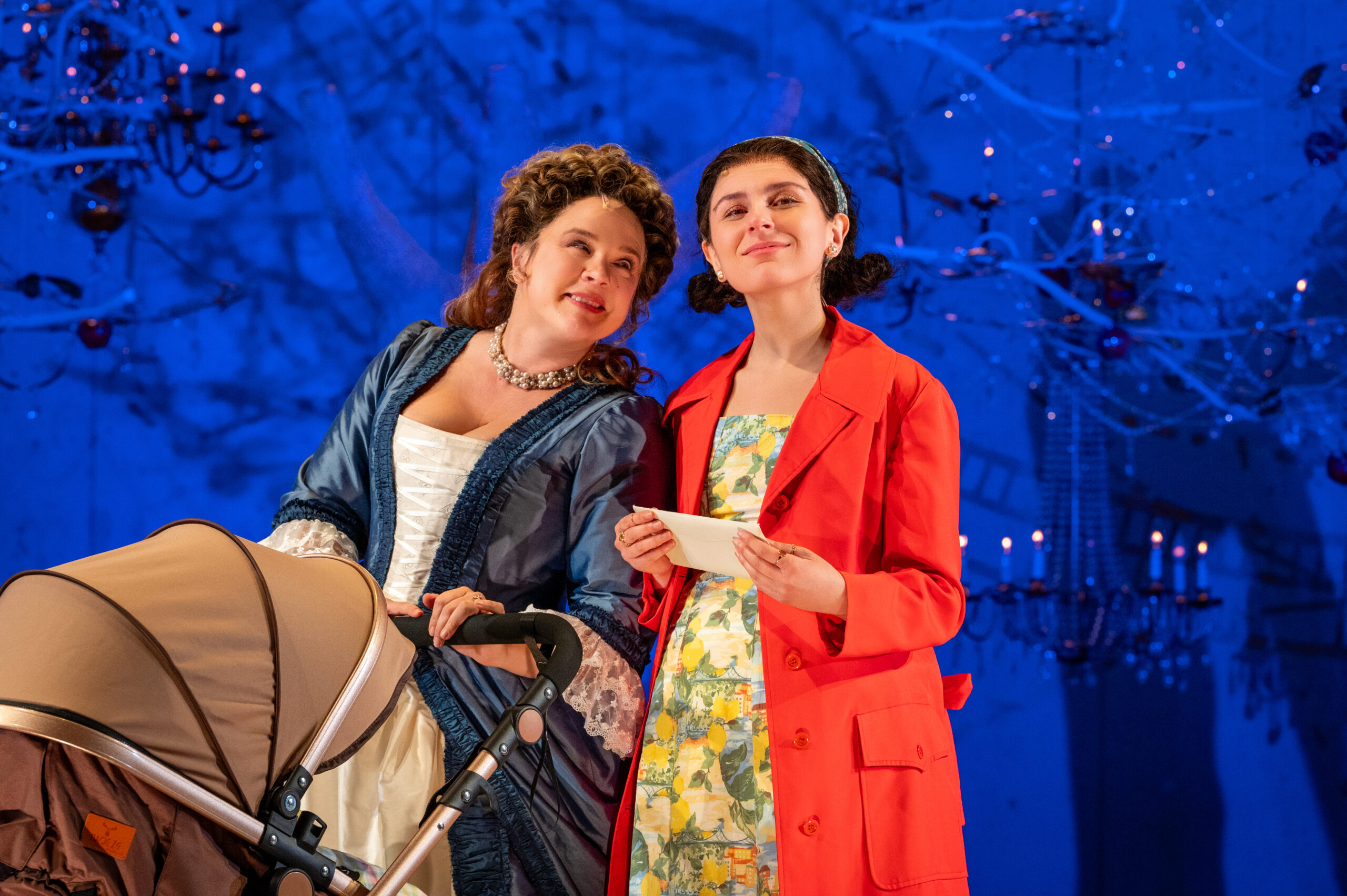Female Scientists from Different Times Share Much in “Legacy of Light”; An Elegant, Witty Script Shines in McCarter’s Lively, Exquisite Production

“LEGACY OF LIGHT”: Performances are underway for “Legacy of Light.” Written by Karen Zacarias and directed by Artistic Director Sarah Rasmussen (assisted by Tiger Brown), the play runs through April 6 at McCarter’s Matthews Theatre. Above: In a meeting that transcends centuries, 18th century scientist Émilie du Châtelet (Lenne Klingaman), left, encounters a modern woman, Millie (Gina Fonseca), who dreams of studying in France to become a fashion designer. (Photo by Daniel Rader)
By Donald H. Sanborn III
Legacy of Light is an example of a play that cannot be fully served by a synopsis, because a plot description is unlikely to do justice to the depth and beauty of the play’s themes and dialogue. It also is an example of a fairly common theatrical conceit — characters transcending their lifetimes to meet each other — that feels fresh and works brilliantly because of deft developed and execution.
In award-winning playwright Karen Zacarias’ elegant and literate comedy, a real-life historical figure, French aristocrat and physicist Émilie du Châtelet (1706-1749), and a contemporary fictional character, astronomer Olivia, share scientific aspirations that are upended by impending motherhood (accidental in Émilie’s case, carefully arranged in Olivia’s).
Beneath this premise lie monologues that probe deep scientific questions about our world and the universe around us; wry commentary about cultural issues and mores; and poignant conversations in which characters share aspirations, as well as emotions – hopes as well as anxieties – about an uncertain future.
McCarter is continuing its season with Legacy of Light. Artistic Director Sarah Rasmussen directs (assisted by Tiger Brown), guiding the talented cast and creative team through a lively, exquisite production.
As the play begins we see a chandelier rise to the ceiling. Because characters spend several lines of dialogue discussing Newton’s (supposed) discovery of gravity via an apple falling from a tree, it is fitting that we see a light fixture – to borrow a phrase from another show — defy gravity.
In mid-18th century France we catch Émilie du Châtelet (portrayed with brisk, feisty charm by Lenne Klingaman) having an affair with Saint-Lambert (a slickly debonair Trey DeLuna). The latter is a pupil of Émilie’s intellectual and romantic partner Voltaire (Allen Gilmore, whose rich baritone voice is well suited to the authoritative delivery of his lines).
Voltaire is (to say the least) displeased by the liaison, and there is a physical confrontation (nicely staged by Fight and Intimacy Coordinator Alicia Rodis), which Émilie attempts to defuse. Immediately, we are introduced to the concept of a fragile balance between opposing forces.
In modern-day New Jersey, we meet Olivia (an exuberant Kimberly Chatterjee, who understands the character’s mixture of a youthful thirst for discovery, and a mature awareness of — and frustration at — her physical and psychological limitations). Olivia is excited by her possible discovery of a nascent planet — new life.
The childless Olivia tells her husband Peter that she wants to make another attempt to start a family. (Peter is played by an affable Zack Fine, who also plays Émilie’s dignified and understanding husband Monsieur du Châtelet). Having survived ovarian cancer, Olivia cannot get pregnant, so the couple decides to try a surrogate mother.
An agency matches the couple with Millie (an energetic and earnest Gina Fonseca), who reveals to them that she hopes to travel to France to study fashion design. Through a conversation Millie has with her controlling brother, Lewis (DeLuna), we discover that she has other motivations for carrying a child to term for Olivia and Peter.
Back in France, Émilie informs Saint-Lambert that she is expecting his child. He replies that he cannot stay, because he has been commissioned to write for the king.
Émilie fears that she will die in childbirth, and that this gives her only months to finish her scientific research and writings. Olivia, who misses Millie’s first sonogram because of work, fears that she is not cut out to be a mother.
Monsieur du Châtelet and Émilie present their daughter, Pauline (Fonseca), with a gift: material for a dress. Pauline is delighted until she learns that the gown must be a wedding dress, because — despite Émilie having promised her that she can study in Paris — her parents now are arranging a marriage for her. Émilie’s pregnancy makes her fearful for her grown daughter’s future.
Later, characters from one time period meet those from another. Connections between characters are revealed, and we discover that physical similarities between certain characters (effected by the device of dual roles) may not be coincidental.
This production happens not to be the play’s premiere. Legacy of Light debuted in 2009 at the Arena Stage in Washington, D.C. A production at San Jose Repertory Theatre followed in 2011.
Nevertheless, in the best sense McCarter’s version feels like a debut. This is partly because one of the play’s settings is local; Olivia works in Princeton. (An 18th century character quips, “Perhaps New Jersey is a very enlightened place.”)
But the predominant reason is that Rasmussen’s direction fits the play as tightly as if Zacarias had written the script with this production in mind. Just as the story links the past with the present, all of the design elements link to reinforce the script’s themes, in the process creating exquisite, translucent stage pictures that give the sense of paintings coming to life.
“The structure of Legacy of Light has us going back and forth between worlds and then breaking rules of space and time,” Rasmussen observes in a program note. She adds that the “characters escape the constraints of society and burst into a space of freedom and potential for transformation allowing for new understanding before returning to the ‘normal’ world.”
Rasmussen’s staging reflects this. She makes considerable use of the entire space of the Matthews Theater; at one point the script has the characters talk to the audience (Klingaman is particularly adept at connecting with individual playgoers). This is a common theatrical concept, but here it is directly connected with the play’s themes. Rasmussen also employs more subtle devices, such as letting characters enter from behind walls.
Honoring the published script’s request, Scenic Designer Andrew Boyce keeps the set “simple and abstract” enough to move seamlessly between time periods; at one point, Émilie and Voltaire are flanked both by chandeliers and an electric lamp. (Sound Designer André J. Pluess contributes to the seamlessness, underscoring transitions between scenes with smooth, syncopated music that often favors string pizzicatos.)
However, the chandeliers and wooden furniture offer a sufficient evocation of the past. French doors bookend the stage; Co-Lighting Designers Jane Cox and Tess James backlight one of the doors to suggest daylight. The juxtaposition of this against the chandeliers, combined with ornate outfits by Costume Designer Raquel Adorno, give the show much of its painting-like quality.
Adorno generally outfits Émilie in blue and white, in imitation of portraits such as those by Marianne Loir or Maurice Quentin de La Tour. Voltaire also wears light blue and white, underlining the rapport between the two intellectuals. Other characters wear bright, rich reds. In one scene, both Émilie and Pauline wear white, blending beautifully with the furniture and lighting.
Two particular tableaux deserve mention. In the first, Olivia gives an astronomy lecture. She is flanked by a starlit sky — an apt image, given that all of the protagonists are concerned about their ultimate place in the universe.
Later — in a reflection of Émilie’s translation of, and commentary on, Newton’s Philosophiæ Naturalis Principia Mathematica — several characters meet in front of an apple tree that is flanked by a deep blue sky. The tree turns out to be lit; memorably, all of the lighting is dimmed excepted for the chandeliers and the lights on the tree, which in tandem evoke majestic starlight.
“Is it possible that Light and Love share the same properties? They must! Love burns…although we cannot see it, smell it, or touch it, we can feel love. It glows.” At its best, theater can be a light to guide us. In many literal ways, Legacy of Light radiantly illustrates this.
“Legacy of Light” runs through April 6 at McCarter’s Matthews Theatre. A post-show discussion will follow the performances on March 30 and April 5. For tickets or additional information, visit www.mccarter.org.

